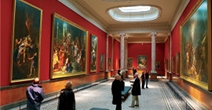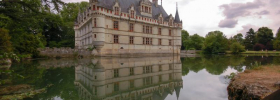 Home
Home- > Tours
- > Pays de la Loire
- > Loire-Atlantique
- > Sion-les-mines
- > Derval region
Derval region
| Topic | Sciences and discovery |
| Departure | SION-LES-MINES (44) |
| Details | We invite you to discover our area of derval. located on the axis nantes-reindeers, halfway between these two cities, our area belongs to the country of chateaubriant, and our history is strongly related to that of brittany. |
"Domaine de la roche" in Marsac-Sur-Don

Green and wooded field of 22 hectares including 9 of water level. Exceptional site which accomodates a camp-site **, a lodging of stage, a rural lodging and an inn. Ideal place of relaxation and leisures with a whole natural panel of activities: excursions pedestrian, equestrian, fishing, course of health, VTT...
Accommodation nearby
Jans village

Jans is formerly the center of important a châtellenie pertaining to the duke of Brittany. The Church: go back to 1868. It is built close to the place where the Romance church, become was too exiguous. It had the characteristic to have a bell-tower with arrow out of needle.
- Martyrdom of Mission: (1895-1947).
Built at the time of the mission of 1895, it is restored at the time of that of 1947. The missions, except in the event of war, take place every ten years during the winter and last three weeks. A team of specialized missionaries ensures animation of it. For this period take place of preachings and the conferences for all on the one hand, and by categories of faithful on the other hand. The mission always finishes Sunday by a great ceremony at the time of which the sanctuary is decorated, and the course, leading instead of a monument or martyrdom inaugurated in this circumstance, decorated garland.
- Paddle wheel of the Mill of the Bridge:
In 1887, the mill includes/ understands a its accessory and steam engine. In 1895, it is equipped with a crusher, and the transportable steam-engine is replaced by an engine running on coke. In 1921, a generator is assembled on the wheel, and a diesel engine is installed. In 1945, the mill is been driven by an electric motor of 20 horses, which intervenes only in complement of the hydraulic force. The mill ceases its activity in 1975.
Accommodation nearby
Visits in Derval
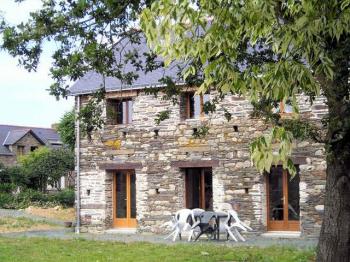
The church Saint Pierre and Saint Paul (1846-XXème century), work of the Ménard architect. This church succeeds a decayed sanctuary.
The chorus goes back to 1846:
It is offered by Miss Blérye and Miss Poligné. The bell-tower goes back to 1950. The large glass one, work of the glass Master Gsell, date of the XXème century.
Five other glass decorates the church:
Those of St Sebastien and the Virgin go back to 1846, the three others represent co. Odile, the priest of Ars and Jeanne d' Arc. The stained glasses represent St Louis, Marie Grignon of Montfort and St Bernard. The Assumption of the Virgin, located at the bottom of the apse, is the work of the sculptor Charles Ménard. Oil on fabric entitled "the Martyrdom of St Sebastien", work of the painter Joly Duval, date of the XIXème century.
Oratory of the Castle (fine of the XIXème century), located at the castle and built with the site where the priory and the vaults dedicated to Clear St and St Denis were established formerly. One still sees there a tumulary flagstone dated from XIVème century and which comes from the vault of the priory St Denis.
The statue St Clear, which comes from the vault of the festivity of Quibut, dates from XIVème century. The statue St Denis dates from XIVème century. The vault of the priory was also useful, seems it of parish church until XVIème century. This vault of the priory was served in XIème century by the monks Benedictines of St Nicolas of Angers, then by the monks of the Abbey St Pierre of Bourgueuil-in-Valley.
The Castle of Garrelaye (XIV-XVIème century). Property of the family Maistre. To announce that in 1364, Alain Maistre takes part in the battle of Auray, in the Montfort camp. In 1487, Pierre Maistre is combined in Francoise de Dinan, baroness of Chateaubriant. Guillaume Maistre adheres to Protestantism and becomes one important personalities of the reformed church of Sion. The north-eastern frontage dates from the XVIIIème century. The castle is with the XIX ème century, the property of Richard Hay de Slade. The tower of guet date of XVème century.
The Tower St Clear in Single Derval keep remaining of a feudal castle of XIIIème century. English stronghold during the One hundred Year old War, which underwent the attacks of Bertrand Duguesclin. The tower is today classified historic building.
After the death of the last lord of Derval in 1482, the feudal fortress loses of its importance. At the time of the wars of religion, it is again used and besieged successively by the antagonists of each camp the Edict of Nantes condemns it to be demolished, but it however accomodates the Protestant prisoners captured with the head office of Port-Louis.
The owners use of them thereafter the stones for other constructions.
Accommodation nearby
Lusanger

Menhirs of Galot this unit megalithic, cut down at the XIXème century during creation of a road, has nine more menhirs and remains the only alignment preserved in the department. Located at the place known as: "grée the galot".
Church St Jean his origins go back for the ones to XIIè-XIIIème century, for the others at the beginning of XVème century.
Perrot Dutay, founder of the first vault, forms the wish to be buried there and that it serf with the public if it is possible to increase it and to make a branch of it. The dedication with St Jean could have been selected to remember it his/her son deceased or his godfather, lord of Derval and giver of this ground.
The vault would have been increased and set up in parish church in XVIème century, Lusanger, becoming trève of Derval. The building was then approximately 50 meters long, and the bell-tower was located in its medium. Located at the Old Borough of Lusanger.
Church St Jean Baptist (1869), the priest of Lusanger, considering that the church which is used then for the worship is not vast enough and is offset too much since the creation of new farms permitted by the clearing, judges good to delocalize the borough and undertakes the construction of a new presbytery. The town council and the commercial ones oppose this project and ask for the replacement of this ecclesiastic, which évêché refuses. Finally the construction of the church is carried out.
Accommodation nearby
Mouais
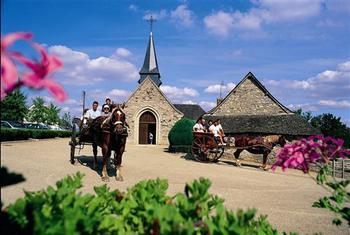
In 864, a monastery is created by the monks Benedictines of Redon. Its territory is composed of two parts: the left bank of Expensive on the one hand, given to the abbey by Austroberte de Fayen, and the bank right on the other hand, given by Erispoë, Breton king and resulting from the parish of Fougeray.
The monks would have settled in this place isolated to protect itself from the Norman invaders, but the latter go up until Mouais, destroy the monastery and plunder the area. In 1062, Quiriac, bishop of Nantes, set up Mouais in parish which it gives to the abbot of Redon.
At the end of XVème century, benefitting from the death of the sior the Clerk of Fouaye, the sior Maistre of Garrelaye, wishing to monopolize the right of enfeu, makes destroy the weapons of Fouaye placed on the stained glasses of the church of Mouais. Its lawsuit with place in Rennes on April 6, 1494 in the presence of the king Charles VIII, but the lord of Garrelaye does not repair the caused damage .
At the beginning of XVIIIè century, a young lady the Large one is arrested and imprisoned to have been used as liaison officer between entreated revolt of Bridge-Kallec, of which the goal was to resist the violations and to safeguard the franknesses whose Brittany with the treaty profited from Union of 1532.
In 1754, Mouais is set up in chatellery.
About 1930, a career of stone extraction is open and develops after the Second World war before closing in 1964, victim of competition.
Accommodation nearby
The pond of the hunaudière
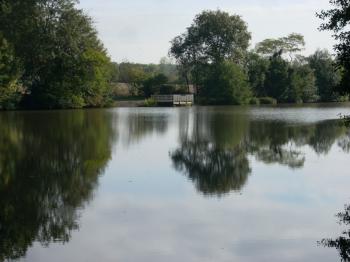
Exceptional site for fishing and possibility of making the turn of the pond on the hiking trail which surrounds it.
Accommodation nearby
Don valley
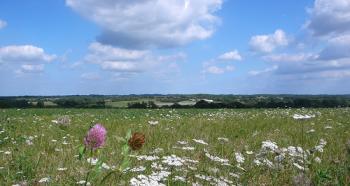
Old railways with St Vincent of the Moors: These old ways allowed formerly the circulation of trains the exceptional gauges. Today, they were rehabilitated in pedestrian hiking road.
Accommodation nearby
Latest news on : Derval region
Tourism near
- 1 Monuments
Tours
 Tour to discover the Loire-Atlantique
Tour to discover the Loire-Atlantique






















